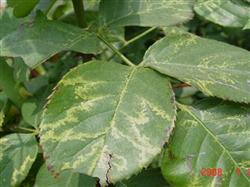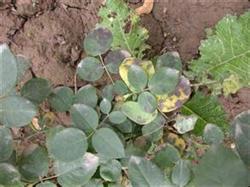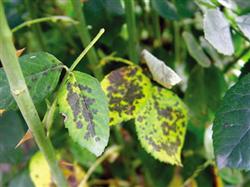Prevention and treatment of rose mosaic disease

Rose mosaic disease is widely distributed, which can cause the decline of the yield and quality of cut rose flowers. Symptoms: the symptoms vary from rose to rose. Rose mosaic virus is characterized by small green spots, sometimes showing polygonal patterns. The leaf surface around the lesion is often more or less deformed. Some symptoms are circular, amorphous wavy markings, and oak leaf-shaped chlorotic spots, which generally have no effect on growth, or have a slight effect on severe dwarfing. Some showed flowers and leaves; some showed a yellowish unimodal curve-like chlorosis zone at the tip or middle of the leaf or near the leaf base, or showed systematic ring spots or oak leaf-like chlorotic spots; some showed yellow veins, leaf deformities and plant dwarfing. Pathogen: there are three known viruses causing rose mosaic disease in China, namely, rose mosaic virus, apple mosaic virus and southern mustard mosaic virus. Rose mosaic virus (RoseMosaicvirus,RMV). The structure of viral material is spherical, about 25 nm. The lethal temperature was 54 ℃, the dilution end point was 1vl 125, and the in vitro survival time was 6 hours (room temperature). The route of transmission: rose mosaic virus is transmitted through juices, grafting and aphids. Rose mosaic virus overwinters in host living tissues, spreads through diseased buds, diseased scions and diseased rootstocks, and spreads disease during budding and grafting. Epidemic characteristics: the suitable temperature for the appearance of the disease is 15-25 ℃. The incidence is very mild when the disease is below 15 ℃. Plants cultivated in greenhouse are more sick than those grown outdoors. The use of diseased plants as reproductive mother plants is the main reason for the increase of diseases year by year. Prevention and control methods: 1. Avoid using susceptible rose as breeding material. Remove the diseased plant and destroy it in time to reduce the source of virus. 2. The virus can be passivated and eliminated by heat treatment at 38 ℃ for one month. 3. Timely spraying to control aphids and other virus-transmitting insects.
- Prev

Grey mildew of rose
Symptoms: when Botrytis cinerea occurs at the leaf edge and tip, at first it is water-stained light brown spots, smooth and slightly sunken, and then expands and decays. The flower bud is sick, and the disease spot is gray and black, which can prevent the flower from blooming and the diseased bud turns brown and dies. When the flowers are invaded, some of the petals turn brown, wrinkled and rotten. Botrytis cinerea also invades the folded flowers.
- Next

Control of mole cricket of Chinese rose
Symptoms: the disease mainly harms the branches of the rose, in the branches and the emergence of ulcer spots, at first a small red spot, and then expand and become deep, but the heart is brown. In the later stage, the lesion was sunken and cracked longitudinally, black spots appeared in the heart of the disease, and black spores emerged when it was wet. In severe cases, the disease spot ring cut the stem, and the branches below the disease shrank and withered.
Related
- Fuxing push coffee new agricultural production and marketing class: lack of small-scale processing plants
- Jujube rice field leisure farm deep ploughing Yilan for five years to create a space for organic food and play
- Nongyu Farm-A trial of organic papaya for brave women with advanced technology
- Four points for attention in the prevention and control of diseases and insect pests of edible fungi
- How to add nutrient solution to Edible Fungi
- Is there any good way to control edible fungus mites?
- Open Inoculation Technology of Edible Fungi
- Is there any clever way to use fertilizer for edible fungus in winter?
- What agents are used to kill the pathogens of edible fungi in the mushroom shed?
- Rapid drying of Edible Fungi

